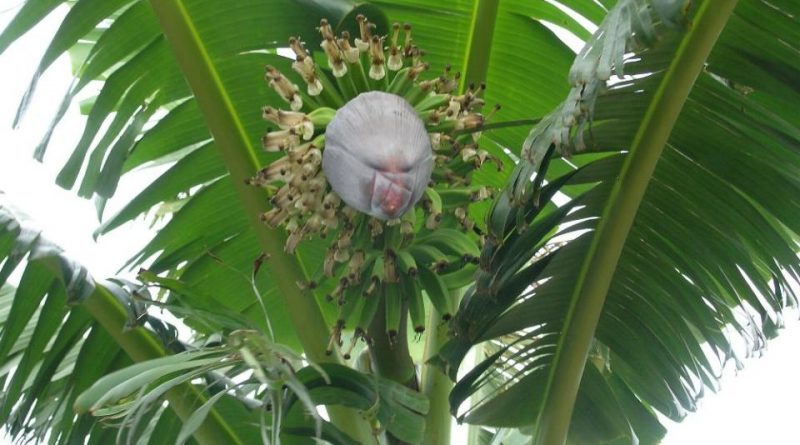Musa acuminata
Musa acuminata
The Banana (Musa acuminata Colla, 1820) is a giant herbaceous plant belonging to the Musaceae family.
Systematics –
From the systematic point of view it belongs to the Eukaryota Domain, Kingdom Plantae, Magnoliophyta Division, Liliopsida Class, Zingiberales Order, Musaceae Family and therefore to the Genus Musa and to the M. Milderata species.
Etymology –
The term Musa comes from the Arabic moz or moza, banana, latinized by botanists in Musa. According to others, the name would recall Antonio Musa, a Roman doctor of the first century. a.C. The specific epithet acuminata derives from acuo, acuere to sharpen, to sharpen: sharp, pointed. The term banana, with which the fruit is known, could derive from the Arab banan, which means “finger”, but is more likely to derive from a sub-Saharan West African language, perhaps from the word of the wolof banaana language.
Geographic Distribution and Habitat –
The Musa acuminata is a plant native to south-east Asia, most probably of the highlands of New Guinea, from which, through crossings, selections and mutations derive almost all modern edible bananas. Today the varieties derived from this species are grown in Central America, Tropical Africa and the Philippines.
Description –
The Musa acuminata is a large tropical herbaceous species that, even if mistaken for trees, their main stem is in a pseudo-stem growing up to 6-7 meters, and growing from a bulb-tuber. Each pseudofrutto can produce a single bunch of bananas that dies after the fruiting. Other suckers grow from the bulb-tuber, so many varieties of bananas are perennial. The leaves are arranged in a spiral with dimensions greater than even 2.5 meters in length and 60 cm in width. They are easily torn by the wind, with the result of appearing often frayed. From each pseudostem, a single inflorescence is produced (rarely if they produce more) containing many bracts. The female flowers appear in rows higher on the stem, compared to the male flowers.
The banana fruits develop from the heart of the banana to form a helmet, comprising 3-20 hands, and can weigh 30-50 kg. Each fruit, called banana, weighs on average 100-150 grams and is composed of 75% of water and 25% of dry substance. The fruit of the Musa acuminata is similar in shape to commercial bananas, deriving from different varieties, but it contains numerous hard seeds.
Cultivation –
Bananas are grown mainly in countries with tropical and sub-tropical climate such as in Central America, Tropical Africa and the Philippines as they have particular climatic requirements. They can also be cultivated in some microclimates of southern island Italy. For the cultivation technique you can consult the present sheet.
Uses and Traditions –
Besides the fruits, the banana is used in the cuisine of Bengal and Kerala (in India) not only for the fruits. In these kitchens are used the banana flowers, raw or cooked. In the same countries and also in Burma, the tender heart of the banana trunk is also used. Another way to consume the fruit is drying. Dried bananas have a dark brown color and a typical and intense flavor. In Rwanda, Burundi, Uganda, Tanzania and the Democratic Republic of the Congo, bananas are fermented to obtain an alcoholic drink called kasiksi.
The inner part of the banana peel is also used by rubbing it on the skin to relieve the irritation caused by the ivy of Canada. Once the skin of the banana was used as a medicine for the treatment of psoriasis.
On average, bananas contain about 75% of water, 23% of carbohydrates, 1% of proteins, 0.3% of fats, and 2.6% of dietary fiber, values that vary according to the varieties and growing conditions.
The banana pulp is rich in vitamin A, vitamin B1, vitamin B2, vitamin C, vitamin PP and, to a lesser extent, contains vitamin E and B6; it also contains calcium, phosphorus, iron, potassium and carbohydrates.
Recent findings and archaeological and paleoenvironmental evidence in the marshes of Kuk, in the Western Highlands Province of Papua New Guinea suggested that the cultivation of the banana dates back to at least 5000 – 8000 BC This would make the highlands of New Guinea the place where the banana was domesticated . It is likely that other species of wild banana were subsequently domesticated in other areas of south-east Asia. The first written texts mentioning the banana for the first time date back to 600 BC. they are Buddhists. It was Alexander the Great who discovered the taste of banana in the valleys of India in 327 BC. Already in 200 AD. a rational cultivation of bananas in China has been detected. However, it was due to the Islamic conquistadors that they exported the banana to Palestine in 650 AD. subsequently the Arabs spread the bananas in almost all of Africa. Then the Portuguese are introduced to the first banana plantations in the Caribbean and Central America in 1502. Today, bananas are among the most consumed fruits in the world.
Preparation Mode –
Bananas in addition to their fresh consumption are used and cooked in different ways. They are consumed in the form of smoothies, alone and with other fruits, milk or syrups, in fruit salads, pies and pies and in various other ways.
Guido Bissanti
Sources
– Wikipedia, the free encyclopedia.
– Treben M., 2000. Health from the Pharmacy of the Lord, Advice and experience with medicinal herbs, Ennsthaler Publisher
– Pignatti S., 1982. Flora of Italy, Edagricole, Bologna.
– Conti F., Abbate G., Alessandrini A., Blasi C. (edited by), 2005. An annotated checklist of the Italian vascular flora, Palombi Editore.
Warning: Pharmaceutical applications and alimurgical uses are indicated for informational purposes only and do not in any way represent a medical prescription; there is therefore no liability for their use for curative, aesthetic or food purposes.


